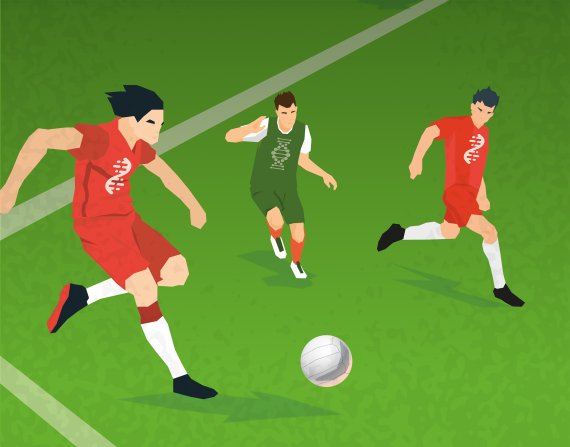illustration Geert-Jan Bruins. photo Guy AckermansHidden genetic variety is a well-known phenomenon. Take a disease that runs in the family but does not affect all the members of a family. They all have the pathogenic gene, but they do not all fall ill. ‘We react differently to genetic pathogens,’ explains Jan Kammenga. He shows two pictures of cancer developing in the intestines of mice. The first shows intestines full of polyps – a stage that precedes cancer –, the second shows clean intestines. ‘Which mouse has the mutation that leads to bowel cancer? Both of them. In the first mouse the cancer gene gets expressed, in the second it doesn’t.’
You see something similar in plants, says Kammenga. ‘Plant breeders might for example find a gene in a particular variety which makes the flower’s colour brighter. But if we build that gene into another variety through cross-breeding, the flowers suddenly turn out much less colourful. That is because the genetic background of the first plant is lacking.’ Doctors and plant breeders are familiar with this pattern from their practice, but they don’t understand the underlying mechanism.

‘I want to find out which players help get the striker into a position to score.’
Jan Kammenga
Striker
The brand-new personal professor of Functional Genetics – he gives his inaugural lecture on 8 December – wants to clarify the mechanism behind hidden genetic variation. He is doing so with the help of the nematode Caenorhabditis elegans. This model organism teaches us a lot about the genetics and biology of humans and animals. ‘With C. elegans I can do research fast and in a controlled way. I can put a gene into several individual worms and then monitor what the characteristics do. Subsequently I can see which genetic background is necessary for a particular characteristic to be expressed. I look for the ‘modifier’, the determining factor.’
Kammenga illustrates this with reference to formations on a football pitch. ‘We know that this team has a strong striker: a gene that makes a big contribution to a disease. But whether the striker scores depends on the rest of the team, or on the genetic network. I want to find out which players get the striker into a position to score. To do that I need to see a lot of different formations. If the striker often scores with the same midfielder, I’ve found the modifier.’
Big data
Kammenga thinks this hidden genetic variation has an effect on all characteristics, even down to eye colour. ‘The questions is whether mono-gene characteristics exist. Maybe eye colour is 90 percent determined by the dominant mutation but 10 percent then depends on the genetic network.’
Kammenga does not know what processes underlie this genetic teamwork. ‘Maybe the way genes collaborate is the crucial factor. It is a major computational challenge to find that out because the interaction between tens of genes generates very many possibilities. This is big data research.’
Nevertheless, Kammenga already has results. ‘We introduced a cancer gene into C. elegans and crossed the specimen with various parent genes so as to get descendent which all had the same mutation in a range of different genetic backgrounds. We identified the DNA order and the degree of cell development for those descendants. We found an enormous variation in protuberances and disturbed cell development, which we could quantify. Because we had the genetic make-up of all the gene’s descendants, we were able to find the modifier, or modifiers. There were several of them, with one gene playing a strong supporting role in the development of cancer.’
Genetic teamwork is particularly difficult to figure out in the case of sexual reproduction, says Kammenga. It is as though at a single moment you substitute thousands of players in your team, too many to be able to figure out what the winning formation was. Plant breeders face a different challenge. If they breed in a desirable characteristic using traditional breeding techniques, they come up against the fact that certain varieties are easy to cross-breed and others are not, for no clear reason. This is where the genetic network comes in, thinks Kammenga. What is more, with breeding you don’t just introduce the desirable gene but you also cause the genetic network to change – with unknown consequences for the expression of the desirable gene.
Decisive pass
The team of genes that has the ball probably varies per characteristic, says the professor. There may be genes which play in several different teams, and besides the star players you can easily be talking about 20,000 or so genes with the potential to make the decisive pass to the striker. And no one knows how big the team is. Nor do Kammenga and his colleagues know whether the modifier has to be in the first team, or whether it can be off form at some moments, and if so, who caused that loss of form. A lot of questions remain unanswered but one thing is certain: this concept of genetic networking calls for modesty, thinks Kammenga. The claim that we will soon be able to make personalized medicines, depending on a person’s genetic passport, is not realistic, he says. ‘That kind of genetic passport doesn’t enable you to say why medicines don’t work on some cancer patients. Nor why some people with the pathogenic gene do not succumb to the disease. It’s more complex than that.’
Crispr-Cas
Moreover, Kammenga doubts whether the proponents of genetic modification can live up to their claim that they can build desirable characteristics into an organism with great precision. ‘I am now doing research on the new Crispr-Cas technique, which is seen as the most precise breeding method. Using this technique we introduce a mutation into various lines of C. elegans. I would be willing to bet that the characteristic changes or disappears in some of the worms. Because no matter how precise the technique is, the mutation will always be influenced by the hidden genetic variation.’

